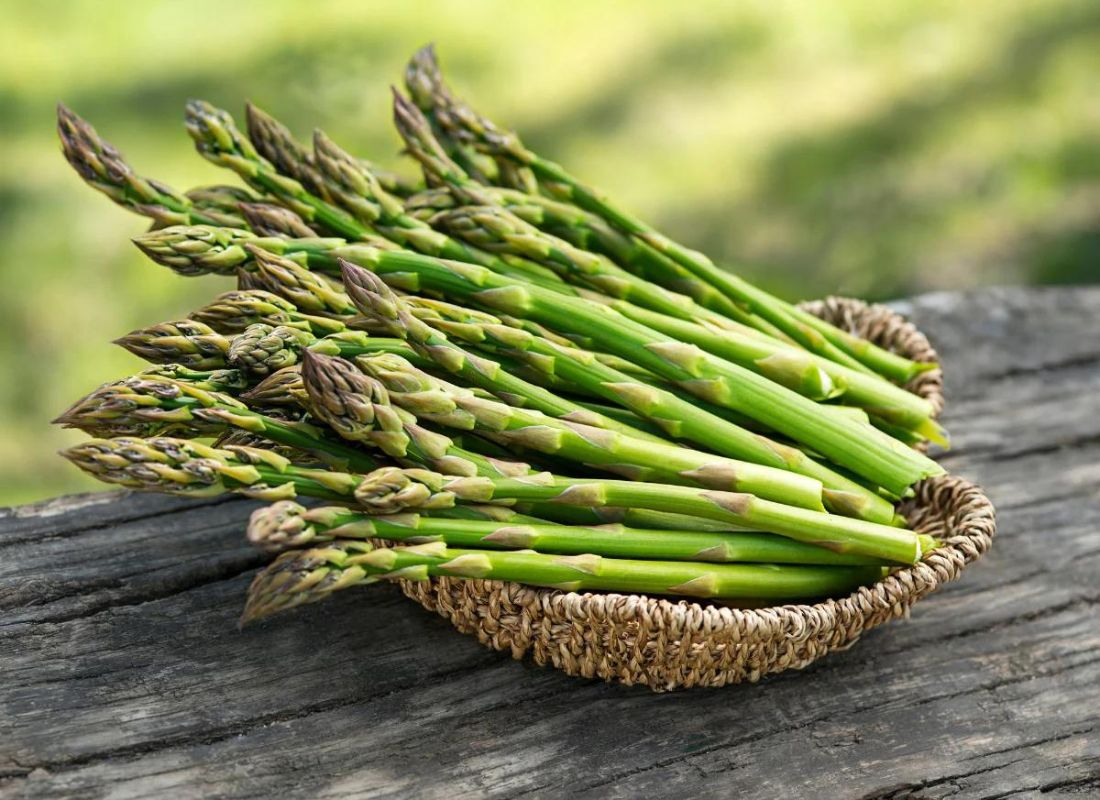There are many ways to eat Asparagus. You can serve it hot, cold, raw, or cooked. In addition, you can use it to fill out the main entrée, or you can serve it as a side dish.
It mixes well into soups, salads, casseroles, and stir-fries. But, you may decide to simply serve it on its own! A fresh Asparagus is a luxury vegetable, and its prices tend to reflect this. You can buy fresh, frozen, or canned asparagus.
If you’re buying fresh, look for bright green or violet-tinged spears. Spears should be straight, firm, and uniformly-sized, with closed (not flowering) tips.

Ideally, buy a fresh one on the day that you plan to use it. Its spears range from thick to thin. Some people prefer one kind over another. But, size does not generally signal quality or flavor.
Thicker spears are more mature, and thinner spears less so. Additionally, thicker spears often have tougher, woodier ends, and most people chop these off before cooking.
Important to realize, it also goes bad quickly. So, it’s important to pick bundles that are refrigerated or on ice. Do not buy asparagus that isn’t being kept cool, as it may go bad even more quickly. But,
What is Asparagus?
Asparagus is a vegetable that comes from the Asparagaceae family. There are more than 200 species within that plant family.
Some species are grown as ornamental plants and others are used by florists in arrangements and corsages. You’re likely most familiar with the garden asparagus, or Asparagus Officinalis.

As shown in the diagram above, it’s a green vegetable known for its slender spears. And it’s often one of the first signs of spring.
Equally important, it’s a natural addition to many spring dishes. From veggie-packed frittatas to salads piled high with the season’s finest ingredients.
The vegetable’s bright, somewhat earthy flavor is only one reason to love it. Not forgetting, it’s also prized for its nutritional benefits. And has also shown to have potential cancer-fighting and diuretic properties.
Why Should You Eat More Asparagus?
Of course, there are a few bits of folk wisdom about it. It’s been said to help with everything from toothaches to reproductive issues.
The toothache relief claim hasn’t held up in modern-day studies though. But, there may be some truth to the other tale. Experts say it’s important for women who want to get pregnant to consume the recommended amounts of folic acid. After all, which is the synthetic form of folate, the B vitamin found in asparagus.
The Centers for Disease Control and Prevention (CDC) says to take in 400 mcg of folic acid per day. In that case, to prevent two common birth defects: spina bifida and anencephaly.
A ½ cup serving of asparagus contains 35 mcg of folate. Meaning you’d need to eat nearly 6 cups of asparagus to meet the recommended daily intake.
So to say, if you are trying to get pregnant and relying solely on asparagus to meet your folate needs. Below are more elaborate benefits.
1. It’s Easy To Add On Your Diet
In addition to being nutritious, it’s delicious and easy to incorporate into your diet.
It can be cooked in a variety of ways, including boiling, grilling, steaming, roasting and sautéing. You can also purchase canned asparagus, which is precooked and ready to eat.
Not to mention, it can be used in a number of dishes like salads, stir-fries, frittatas, omelets, and pastas, and it makes an excellent side dish.
Furthermore, it’s extremely affordable and widely available at most grocery stores. When shopping for fresh asparagus, look for firm stems and tight, closed tips.
2. Improves Digestive Health
As a matter of fact, dietary fiber is essential for good digestive health. Just half a cup of asparagus contains 1.8 grams of fiber, which is 7% of your daily needs.
Studies suggest that a diet high in fiber-rich fruits and vegetables may help reduce the risk of high blood pressure. As well as, heart disease, and diabetes. It’s particularly high in insoluble fiber. And in that case, which adds bulk to the stool while supporting regular bowel movements.
And on the other hand, it also contains a small amount of soluble fiber. Dissolving water and forming a gel-like substance in the digestive tract. These soluble fibers feed the friendly bacteria in the gut too. Such as Bifidobacteria and Lactobacillus.
Therefore, increasing the number of these beneficial bacteria plays a role in strengthening the immune system. And producing essential nutrients like vitamins B12 and K2.
So, eating asparagus as part of a fiber-rich diet is an excellent way. To help meet your fiber needs and keep your digestive system healthy.
3. Good Source Of Antioxidants
Antioxidants are compounds that help protect your cells from the harmful effects of free radicals and oxidative stress. Bearing in mind, oxidative stress contributes to aging, chronic inflammation and many diseases, including cancer.
Like other green vegetables, it’s high in Antioxidants. These include vitamin E, vitamin C, and glutathione, as well as various flavonoids and polyphenols. And it’s particularly high in the flavonoids quercetin, isorhamnetin and kaempferol.
These substances have been found to have blood pressure-lowering, anti-inflammatory, antiviral and anticancer effects. Particularly, in a number of human, test-tube and animal studies.
What’s more, purple asparagus contains powerful pigments called anthocyanins. Basically, which gives the vegetable its vibrant color and has antioxidant effects in the body.
In fact, increasing anthocyanin intake has been shown to reduce blood pressure and the risk of heart attacks and heart disease.
Therefore, eating it along with other fruits and vegetables can provide your body with a range of antioxidants to promote good health.
4. Few Calories & More Nutrients
By the same token, it’s low in calories but boasts an impressive nutrient profile.
In fact, just half a cup (90 grams) of cooked asparagus contains:
- Calories: 20
- Protein: 2.2 grams
- Fat: 0.2 grams
- Fiber: 1.8 grams
- Vitamin C: 12% of the RDI
- Phosphorous: 5% of the RDI
- Vitamin A: 18% of the RDI
- Potassium: 6% of the RDI
- Vitamin K: 57% of the RDI
- Folate: 34% of the RDI
- Vitamin E: 7% of the RDI
It also possesses small amounts of other micronutrients, including iron, zinc, and riboflavin. It’s an excellent source of vitamin K, an essential nutrient involved in blood clotting and bone health.
In addition, asparagus is high in folate, a nutrient that is vital for a healthy pregnancy and many important processes in the body, including cell growth and DNA formation.
5. Body Cells Damage Protection
Eating Antioxidants (like asparagus ) can protect against the cell damage that free radicals cause, known as oxidative stress.
Activities and processes that can lead to oxidative stress include:
- mitochondrial activity
- excessive exercise
- tissue trauma, due to inflammation and injury
- ischemia and reperfusion damage
- consumption of certain foods, especially refined and processed foods, trans fats, artificial sweeteners, and certain dyes and additives
- smoking
- environmental pollution
- radiation
- exposure to chemicals, such as pesticides and drugs, including chemotherapy
- industrial solvents
- ozone
Such activities and exposures can result in cell damage.
This, in turn, may lead to:
- an excessive release of free iron or copper ions
- activation of phagocytes, a type of white blood cell with a role in fighting infection
- an increase in enzymes that generate free radicals
- a disruption of electron transport chains
All of these can result in oxidative stress.
The damage caused by oxidative stress has been linked to cancer, atherosclerosis, and vision loss. It is thought that free radicals cause changes in the cells that lead to these and possibly other conditions.
Intake of antioxidants is believed to reduce these risks. According to one study: Antioxidants act as a;
- radical scavenger,
- hydrogen donor,
- electron donor,
- peroxide decomposer,
- singlet oxygen quencher,
- an enzyme inhibitor,
- synergist, and
- metal-chelating agents.
Other research has indicated that antioxidant supplements may help reduce vision loss due to age-related macular degeneration in older people.
Overall, however, there is a lack of evidence that a higher intake of specific antioxidants can reduce the risk of disease.
In most cases, results have tended to show no benefit or a detrimental effect, or they have been conflicting.
6. Helps Lower Blood Pressure
High blood pressure affects more than 1.3 billion people worldwide and is a major risk factor for heart disease and stroke.
Research suggests that increasing potassium intake while reducing salt intake is an effective way to lower high blood pressure. Potassium lowers blood pressure in two ways: by relaxing the walls of blood vessels and excreting excess salt through urine.
Asparagus is a good source of potassium, providing 6% of your daily requirement in a half-cup serving. What’s more, research in rats with high blood pressure suggests that asparagus may have other blood pressure-lowering properties.
In one study, rats were fed either a diet with 5% asparagus or a standard diet without asparagus. After 10 weeks, the rats on the asparagus diet had 17% lower blood pressure than the rats on the standard diet.
Researchers believed this effect was due to an active compound in asparagus that causes blood vessels to dilate. However, human studies are needed to determine whether this active compound has the same effect on humans.
In any case, eating more potassium-rich vegetables, such as asparagus, is a great way to help keep your blood pressure in a healthy range.
7. Healthy Pregnancy Support
Another key point, Asparagus is an excellent source of folate, also known as vitamin B9.
Just half a cup of asparagus provides adults with 34% of their daily folate needs and pregnant women with 22% of their daily needs.
Folate is an essential nutrient that helps form red blood cells and produce DNA for healthy growth and development. It’s especially important during the early stages of pregnancy to ensure the healthy development of the baby.
Getting enough folate from sources like asparagus, green leafy vegetables and fruit can protect against neural tube defects, including spina bifida.
Neural tube defects can lead to a range of complications, ranging from learning difficulties to lack of bowel and bladder control to physical disabilities.
In fact, adequate folate is so vital during pre-pregnancy and early pregnancy that folate supplements are recommended to ensure women meet their requirements.
8. Can Help You Lose Weight
Currently, no studies have tested the effects of asparagus on weight loss. However, it has a number of properties that could potentially help you lose weight.
First, it’s very low in calories, with only 20 calories in half a cup. This means you can eat a lot of asparagus without taking in a lot of calories.
Furthermore, it’s about 94% water. Research suggests that consuming low-calorie, water-rich foods is associated with weight loss.
Secondly, it’s also rich in fiber, which has been linked to lower body weight and weight loss.
How do I Cook Asparagus at Home?
Fresh asparagus is quick and easy to cook, and makes any meal feel just a little more special.
No wonder I love it when asparagus season hits and the price drops so we can eat it all the way we can hold. I’ll show you how to cook it fresh in six simple ways, complete with top tips and recipes to try.

Before you try any of the methods for cooking asparagus, you’ll want to trim up the asparagus stalks.
Trimming it is a “snap.” To remove and discard the tough woody ends of the stalks before cooking, you can just cut them off with a knife. But what’s more, fun is to use your hands to snap the stalks in two.
They naturally snap at about the point where the woody part begins. Once you’ve snapped your asparagus, you can line them up and give the ends one last neat trim, if you’d like.
To Peel or Not to Peel
Asparagus spears range in size from thicker than your thumb to thinner than a pencil.
If yours is on the thicker side, you might want to peel the woody stalks with a vegetable peeler.
Some cooks also like to trim off the tiny leaves on the stems. But unless they’re very spiky, you can leave them on.
Top Tips for Cooking
If tender, it’s so easy to cook, and even easier to get wrong.
It can go from bright green and tender-crisp to limp and mushy in a flash.
Here’s how to avoid overcooking your;
- Allow plenty of extra spears for testing as you cook.
- No matter which cooking method you choose, the residual heat will continue cooking it.
- Remove it from the stove/grill/oven when it’s almost done to your taste.
- If you’re blanching and reheating it, remove it from the boiling water when it’s still a bit crisper than you like.
The reheating will finish cooking the spears.
1. How to Steam Asparagus
It’s held in a basket to cook gently over steaming water. You can use an upright steam basket or a collapsible steaming basket.
Steaming is good for cutting calories, as it requires little or no fat.
Read and learn more about what to look for in a food steamer
2. How to Cook Asparagus on the Stove
Boiled or Blanched, it’s cooked very quickly in boiling water until it’s fully or partially cooked. If you’re not serving the asparagus immediately, plunge it into a pan of ice water to halt the cooking.
This will also preserve the bright green color. Some recipes call for partially cooking — or blanching it. Or rather, icing it, then finishing the cooking later.
Place the trimmed pieces in a skillet large enough to hold it and enough salted water to cover by about 1/2 inch. Cover and bring to a boil. Cook until just tender, testing frequently.
3. How to Cook Asparagus in the Microwave
Place it in a microwave-safe dish with 2 tablespoons of water.
Cover and microwave on high for about 3 minutes. Stir, and microwave for another 2 to 3 minutes until the spears are firm but tender.
Finally, drain the contents and cool.
Recipes to Try:
4. How to Cook Asparagus in the Oven
The blast of heat caramelizes the natural sugars in the asparagus and deepens the flavor.
Note that roasting could brown the spears, and they won’t appear to be as plump as when they’re steamed or blanched. Yet, the enhanced flavor is worth it.
For this method, place it in a single layer on a shallow pan and cooked in the oven at high heat. This video for Oven-Roasted Asparagus shows you how it’s done.
Recipes to Try:
5. How to Cook Asparagus in a Pan or Skillet
Asparagus is cooked in oil or butter in a skillet, as in this video for Sautéed Garlic Asparagus.
Recipes to Try:
6. How to Cook Asparagus on the grill
Cooking it on the grill is quick and easy and adds a delicious smoky flavor to the finished dish.
You can lay trimmed and seasoned asparagus spears directly across the grill grates. Or even, corral the spears in a grill basket, or grill them in a pan.
But, don’t walk away, because they’re ready in a flash.
Recipes to Try:
As a matter of fact, you can also try this recipe: Grilled Lemon Parmesan Asparagus. Or even Get the entire collection of Recipes!
Takeaway,
As can be seen, Asparagus is a nutritious and tasty addition to any diet. It’s low in calories and a great source of nutrients. Including fiber, folate and vitamins A, C and K.
Additionally, eating it has a number of potential health benefits. Such as weight loss, improved digestion, healthy pregnancy outcomes and lower blood pressure. Plus, it’s inexpensive, and also easy to prepare. Making it a delicious addition to a number of recipes.
Finally, I hope the above revised recipe guide on the benefits of Asparagus and how to prepare it was useful. But, if you’ll have some questions, recommedations or even suggestions, please Contact Us. You can also leave your thoughts in the comments box below this blog.
Get Free Updates
Notice: All content on this website including text, graphics, images, and other material is intended for general information only. Thus, this content does not apply to any specific context or condition. It is not a substitute for any licensed professional work. Be that as it may, please feel free to collaborate with us through blog posting or link placement partnership to showcase brand, business, or product.




